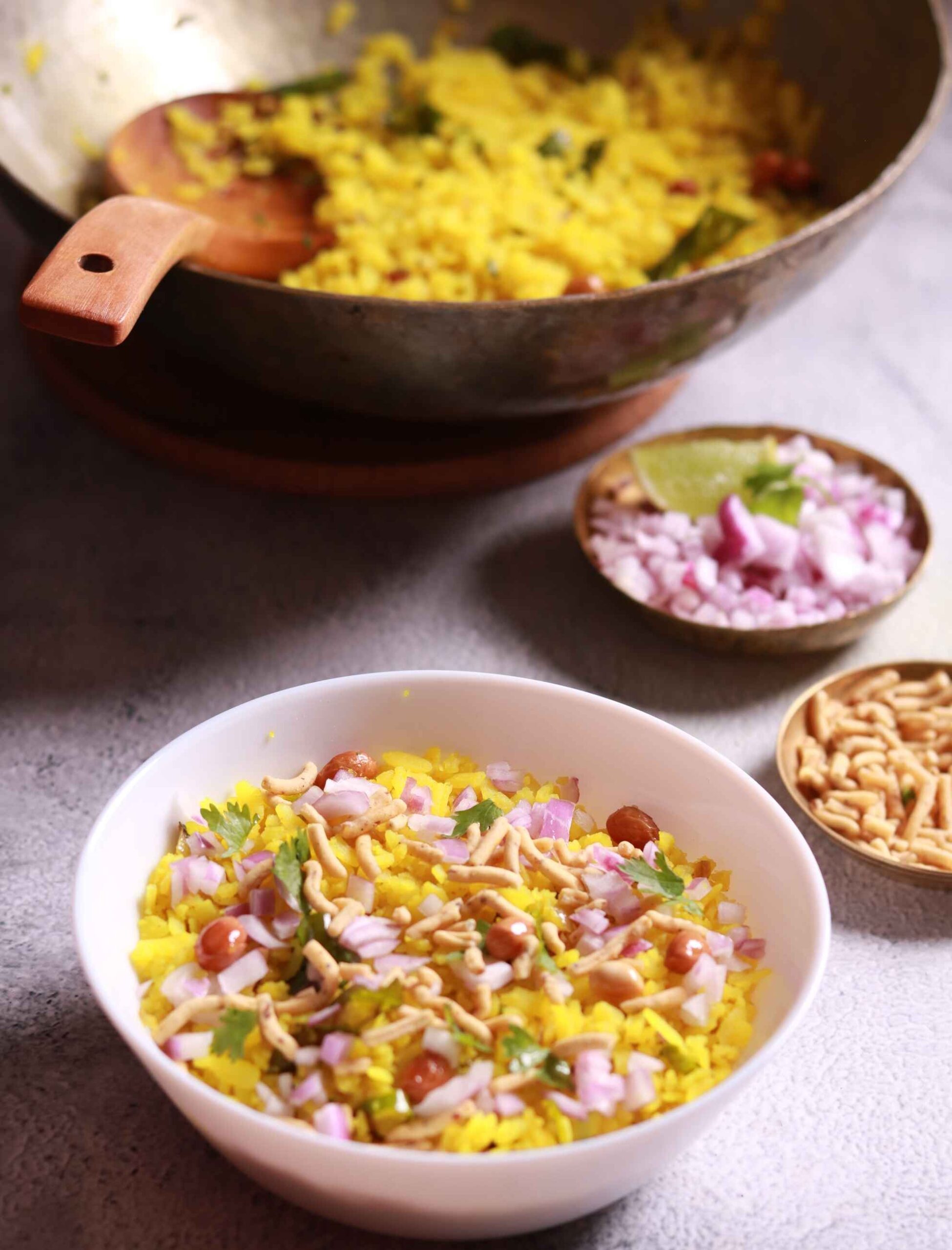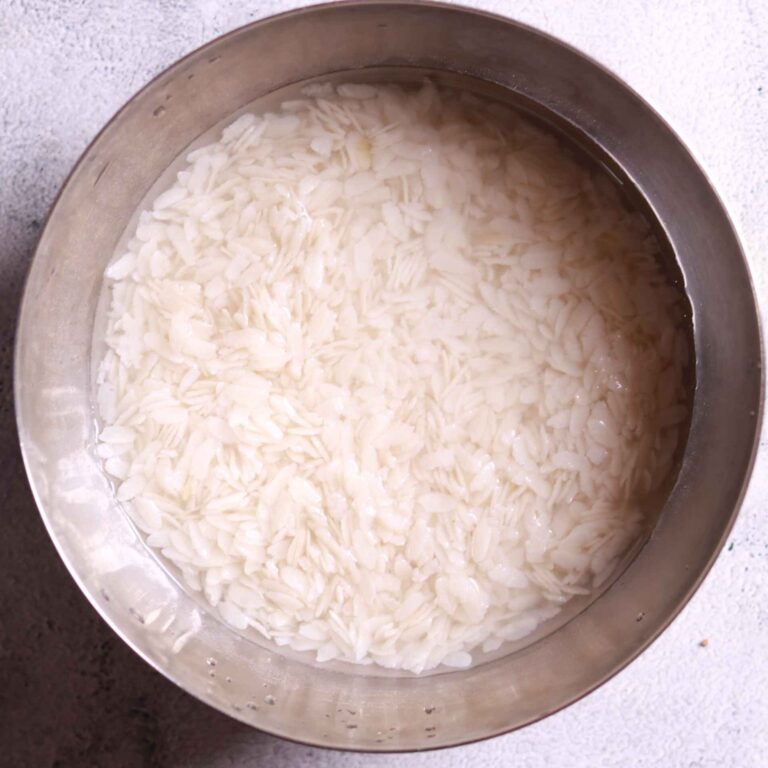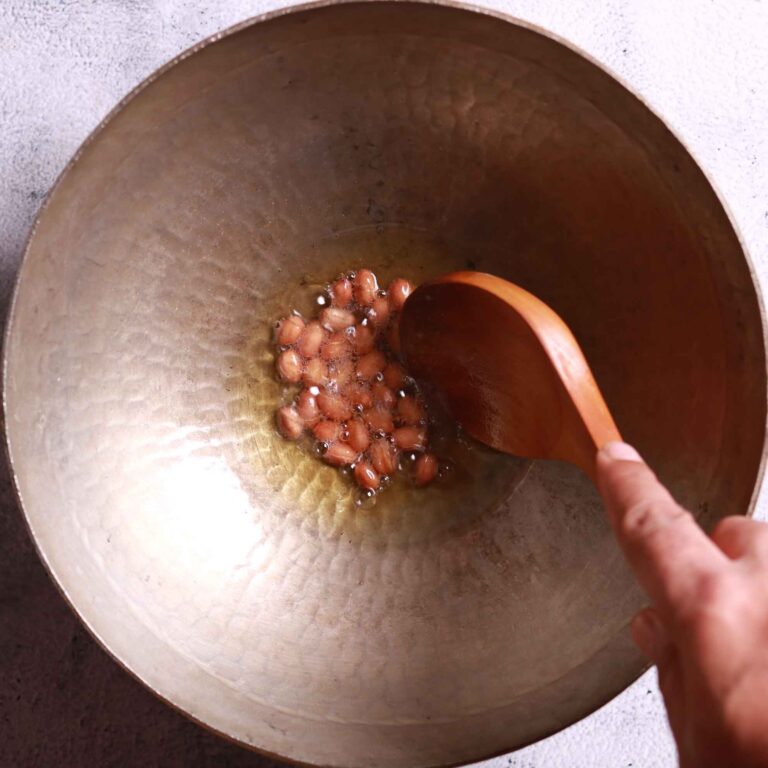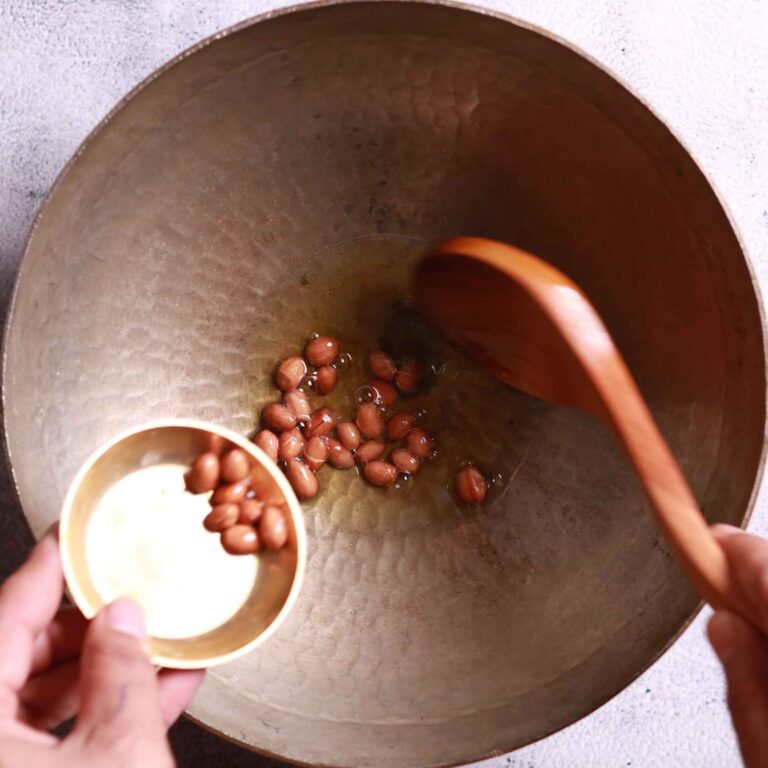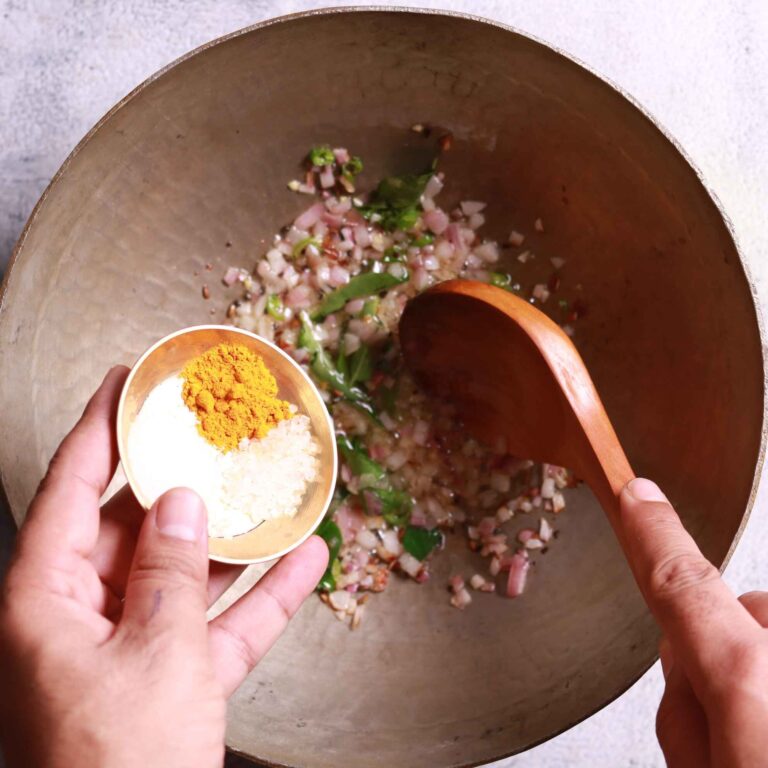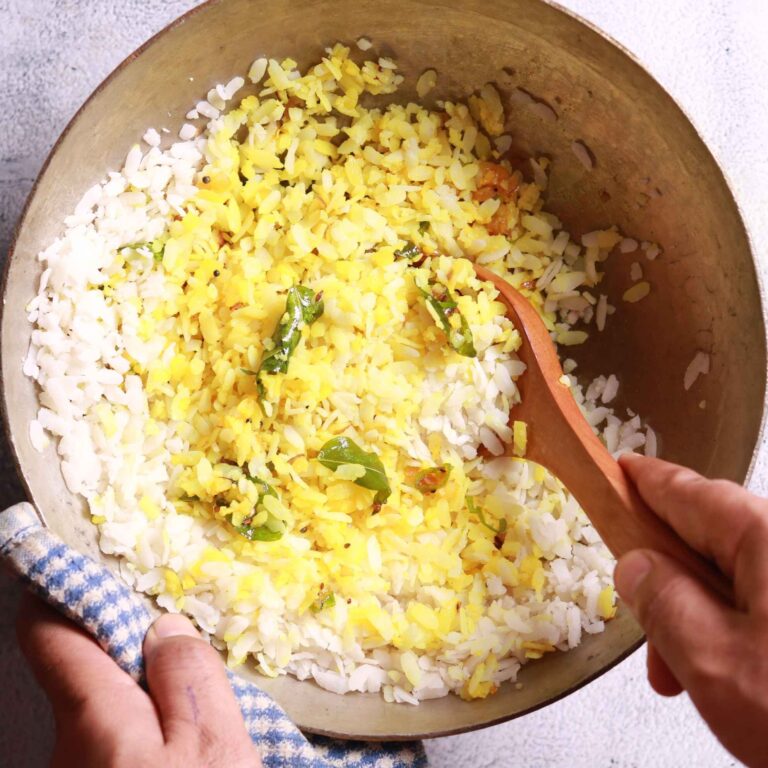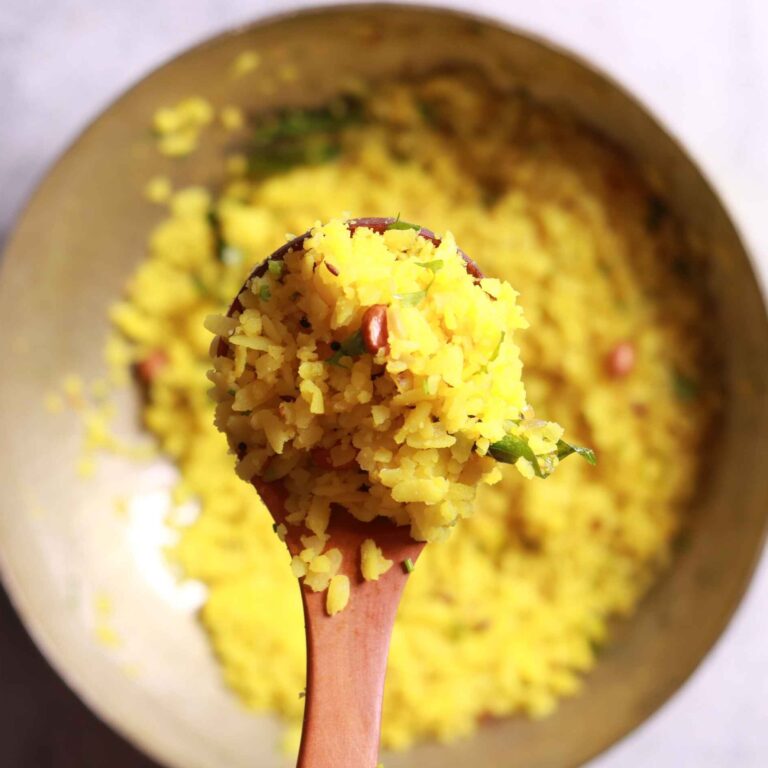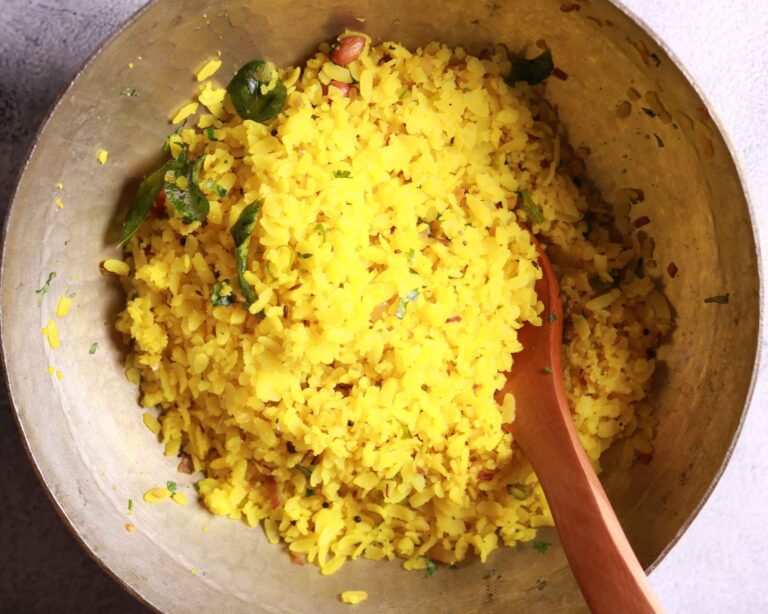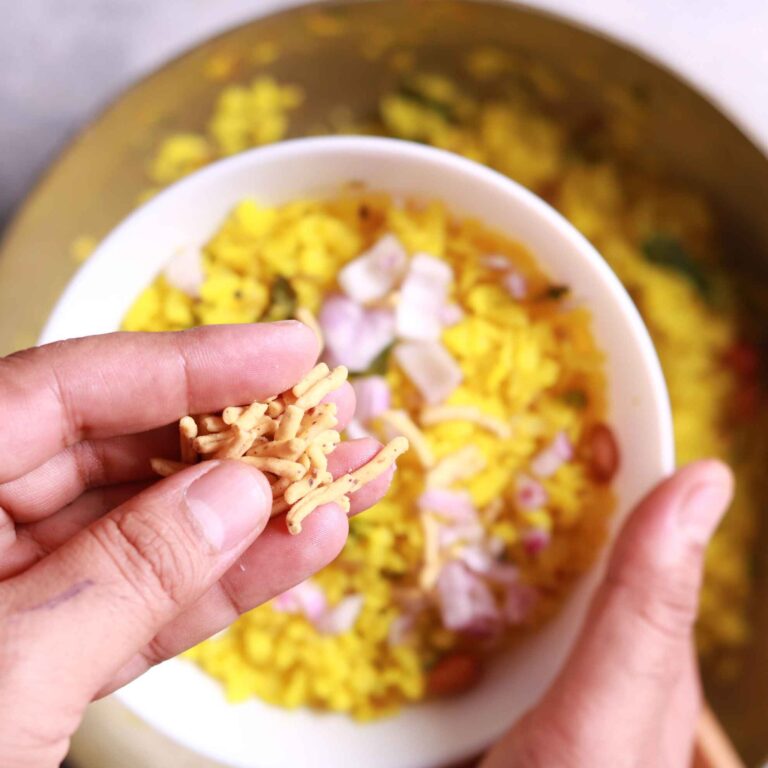Easy and Healthy Vegetable Poha Recipe- Struggling to kickstart your day with a nutritious breakfast? Vegetable Poha, a traditional Indian dish, might just be your solution. Combining the simplicity of flattened rice with the distinct flavors of mustard and sev, this meal not only fills but also packs a powerful nutritional punch. In the upcoming sections, we’ll walk you through selecting the essential ingredients, the steps to prepare this delightful breakfast, and tips to master the dish. You’ll discover the health benefits that make Vegetable Poha an excellent start to your day and some creative variations to keep your mornings interesting.
Why I LOVE… This Recipe!

It’s the PERFECT breakfast: quick, healthy, and BURSTING with flavor. The fluffy rice flakes soak up spices like a dream. It’s COMFORT FOOD that’s actually good for you! Versatile and DELICIOUS, poha never fails to brighten my mornings. Plus, it’s LIGHT yet satisfying and keeps me energized all day. POHA POWER!
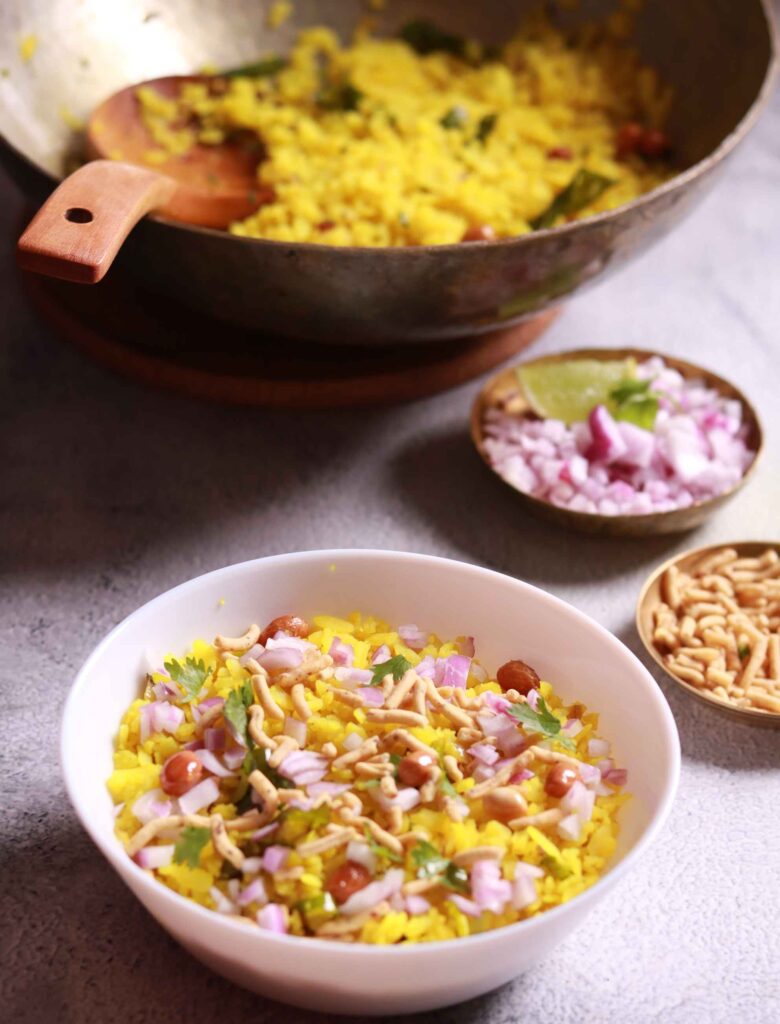
What Is Vegetable Poha?
Originating from the Indian subcontinent, poha is a beloved breakfast dish renowned for its light texture and high nutritional content. Prepared from flattened rice, the dish is typically seasoned with turmeric and garnished with fresh coriander, offering a delightfully savory taste. Its widespread popularity stems from its simplicity and quick preparation time, making it an ideal morning meal.
Origins and Cultural Significance
Poha traces its origins to the Indian subcontinent, where it has secured a place in the pantheon of quintessential breakfast foods. As a testament to its enduring appeal, the dish has not only become a staple in Indian households but has also gained international recognition for its health benefits. The traditional preparation involves soaking flattened rice and lightly frying it with turmeric, mustard seeds, and often a squeeze of lemon juice for a bright, acidic kick. A staple worth embracing for its cultural resonance and healthful twist, vegetable poha has adapted over time, incorporating a colorful array of vegetables like carrots for added texture and nutrition.
Popularity as a Breakfast Choice
Vegetable poha‘s rising popularity as a breakfast option lies in its versatility and health benefits. It’s a fantastic choice for individuals seeking a nutritious start to their day without compromising on flavor or spending excessive time on preparation. Moreover, its adaptable nature allows for the inclusion of a range of seasonal vegetables, meaning that each serving of vegetable poha comes packed with fiber, vitamins, and minerals essential for maintaining a balanced diet.
Nutritional Value of Poha
Vegetable poha stands out as a nutritious breakfast choice loaded with the goodness of essential nutrients. The flattened rice at the heart of the dish is a reliable source of carbohydrates, providing the energy needed to kick-start the day. When combined with a medley of vegetables such as peas, carrots, and onions, the dish becomes a fiber-rich meal that aids digestion and ensures steady blood sugar levels, essential for maintaining a healthy metabolism.
Essential Ingredients for Vegetable Poha
For those embracing a healthier lifestyle, our easy and nutritious vegetable poha recipe begins with selecting the best-quality flattened rice. Including a mix of fresh vegetables such as carrots, peas, and onions adds color, crunch, and essential nutrients to your breakfast
Selecting the Right Type of Flattened Rice
Selecting the right type of flattened rice is crucial for crafting the perfect vegetable poha. A finer grain ensures quicker absorption of flavors while still retaining a delicate bite after cooking. When shopping, look for flattened rice that appears clean, unbroken, and free from any debris to ensure the quality and taste of your breakfast meal.
The thickness of the flattened rice you choose can greatly affect the texture of the poha. Thin varieties of flattened rice tend to become mushy if soaked for too long, while thicker grains might require additional soaking time to achieve the desired softness. Understanding these subtle differences helps in achieving a vegetable poha that is both nourishing and satisfying to the palate.
Finishing Touches Before Serving
The final touch to your vegetable poha involves a sprinkle of fresh coriander leaves, which introduce a burst of color and a fragrant, herby flavor that ties the dish together. To cater to different palates, consider offering sliced lemon on the side for those who prefer a zesty note to their meal. This personalized approach ensures each person can enjoy their breakfast precisely how they like it, with the added benefit of vitamin C from the lemon, enhancing both the taste and the nutritive value of the poha.
Tips for Making the Perfect Vegetable Poha
Achieving the perfect vegetable poha involves more than simply mixing ingredients; it requires careful attention to the balance of flavors and textures, along with the flexibility to adjust spice levels according to personal preference. Optimizing the nutritional value with additional ingredients is equally crucial for a breakfast that is as healthful as it is tasty. In the following sections, we’ll explore practical tips that ensure your poha is not only delicious but also caters to varied tastes and nutritional needs.
Washing and Soaking the Poha
Starting your vegetable poha with properly washed and soaked flattened rice is the cornerstone of a successful dish. A thorough rinse under running water helps in removing any impurities and excess starch, ensuring that the poha is free from grit and doesn’t clump together during cooking. Soaking the rice for just the right amount of time softens the flakes without making them too soggy, essential for achieving that signature light and fluffy texture.
It’s important to tailor the soaking time to the thickness of the poha — a general rule is to immerse the grains until they’re just soft enough to break between your fingers. This essential step lays the groundwork for your healthy breakfast, allowing the flattened rice to perfectly absorb the symphony of flavors from the spices and veggies that will follow. Keep an eye on the clock to avoid over-soaking, which can lead to a less than ideal consistency in your vegetable poha.
Balancing Flavors and Textures
To create the perfect vegetable poha, it’s essential to achieve a harmonious balance between the softness of the soaked flattened rice and the crunch of fresh vegetables. Ensuring this texture contrast is key to an enjoyable eating experience. The trick lies in cooking the vegetables just right – they should retain a bite yet be cooked through – and integrating them with well-soaked poha that remains distinct and not mushy.
Adjusting Spice Levels to Taste
Mastering the perfect vegetable poha means tuning the spice levels to individual taste, thereby transforming a simple breakfast dish into a personalized culinary delight. The key is starting with conservative amounts of spices like mustard seeds, cumin, and green chilies, then adjusting them upward as needed to cater to those who savor a more robust flavor.
Health Benefits of Vegetable Poha for Breakfast
Vegetable poha is more than just a flavorsome start to your day; it’s a treasure trove of health benefits. A key perk of this dish is its natural energy-boosting properties, ideal for kickstarting your morning routine. It also supports digestion and metabolism, owing to its high fiber content. Rich in essential nutrients, vegetable poha delivers a wholesome meal that can keep you nourished and satiated. In the following discussion, we will dive into how this light yet hearty breakfast optimizes energy levels, enhances digestive health, and packs a punch with vitamins and minerals crucial for overall well-being.
Boosting Energy Levels Naturally
Starting the day with vegetable poha serves as an excellent source of natural energy. The complex carbs in the rice provide long-lasting fuel while the added vegetables supply vital nutrients, ensuring one’s body gets a robust start without the need for processed sugars or caffeine.
Supporting Digestion and Metabolism
Vegetable poha is not only a satisfying breakfast option but also a fantastic ally for digestive health. Its high fiber content, derived from both the flattened rice and the assortment of vegetables, aids in the smooth functioning of the digestive system.
Incorporating Essential Nutrients
Vegetable poha is a nutritional powerhouse, bringing together a rich tapestry of essential nutrients in one simple dish. Among its many benefits, vegetable poha is a convenient source of iron, especially when made with leafy greens or garnished with peanuts. This iron content is vital for preventing fatigue and maintaining healthy blood cells, illustrating how this traditional Indian dish is more than just a tasty breakfast—it’s a meal that fortifies the body’s nutritional foundations.
Explore More Indian Breakfast Recipes
- Nutrient-Packed Gaith ki Dal Paratha Recipe – Wholesome and Delicious!
- Sprout Chilla: Dive into Nutritious Lentil Chilla Recipe Today
- Semiya (Vermicelli) Upma Recipe: Quick Indian Breakfast
- Upma: A Simple Yet Delicious Breakfast Option You Should Try!
Vegetable Poha: Photo Gallery










Serving Suggestions and Variations
Serving a dish of vegetable poha offers ample room for customization and variety, Adapting the recipe to fit different dietary needs ensures that everyone can enjoy this nutritious breakfast option. The forthcoming sections will provide practical suggestions for sides, flavor enhancements, and recipe modifications to make vegetable poha an adaptable, delicious choice for your morning routine.
Pairing Poha With Side Dishes
Enhancing your vegetable poha with the right side dishes can transform this humble breakfast into a gourmet experience. For instance, pairing poha with a refreshing cucumber raita brings a cool, creamy contrast to the warm, savory flavors, while a side of tangy mango pickle can add a zesty punch which many palates appreciate in the morning. My personal favourite is Chai (Tea) with Poha.
Creative Add-Ins for Extra Flavor
To infuse your vegetable poha with an extra layer of flavor, consider incorporating roasted cashews or almonds, which add a delightful crunch and a nutty richness. This not only enhances the taste but also increases the protein content, making your breakfast both more satiating and nutritious. A sprinkling of these nuts can invigorate each bite with a contrast in texture that complements the softness of the poha.
Adapting the Recipe for Different Dietary Needs
Adapting vegetable poha to cater to different dietary needs ensures inclusivity and flexibility in the kitchen. For gluten sensitivity, ensure the flattened rice is certified gluten-free, as cross-contamination might be an issue. Another variation includes using coconut oil and omitting mustard seeds to make the recipe suitable for those with nut allergies or following a paleo diet.
For vegans, replacing the traditional ghee with plant-based oils and skipping any dairy-based garnishes such as curd is essential to align the dish with their dietary preferences. Meanwhile, those watching their glycemic index can incorporate more fibrous vegetables and legumes, ensuring a low-sugar breakfast option that’s both wholesome and health-conscious.
FAQ: Everything You Need to Know About Poha
- Is poha gluten-free?
Yes, poha is naturally gluten-free as it’s made from rice. However, always check the packaging and read the declaration. I prefer using a branded pack. - Can I make poha ahead of time?
While poha is best served fresh, you can prepare and reheat it. Store it properly in an airtight container in the refrigerator and consume it within 1-2 days. - What’s the best way to rinse poha?
Rinse poha quickly under running water or in a colander. Avoid soaking it for too long, as it can become mushy. Drain well and let it sit for a few minutes to soften before using. - Can I add vegetables to my poha?
Absolutely! Adding vegetables like peas, carrots, or potatoes is a great way to boost the nutritional value of your poha. Just be sure to cook them until tender before adding the poha. - Is poha good for weight loss?
Poha can be part of a weight loss diet as it’s low in calories and fat. However, portion control is key, and it’s best to pair it with protein and vegetables for a balanced meal. - How can I make my poha spicier?
To increase the heat, you can add more green chilies or include red chili powder in your recipe. You can also experiment with spice blends like garam masala or the special jeeravan masala used in Indori Poha.
Step-by-Step Guide to Preparing Vegetable Poha
Ingredients
For the Poha:
- 1 ½ cups poha flattened rice
- Water for soaking
For the Tempering
- 1 tbsp vegetable oil
- 1 tbsp raw peanuts
- 1/8 tsp cumin seeds
- 1/8 tsp mustard seeds
- 1 small red onion finely chopped
- 1 green chili finely chopped
- 1 sprig curry leaves
- 1/2 tsp turmeric powder
- 1 tsp salt
- 1 tsp sugar
For Garnish:
- 1 tbsp fresh coriander leaves chopped
- Sev optional
- Lemon wedges optional
Instructions
- Soak the poha: Rinse the poha in a colander under running water for about 5 minutes. Drain completely and set aside for 10 minutes to allow it to soften.
- Prepare the tempering: Heat oil in a large wok or kadai over medium heat. Add peanuts and fry for 1 minute until golden brown. R
- Remove with a slotted spoon and set aside.
- Temper the spices: In the same oil, add mustard seeds and cumin seeds. Allow them to crackle for about 30 seconds.
- Sauté the aromatics: Add chopped onion, green chili, and curry leaves. Sauté for 3-4 minutes until the onions turn translucent.
- Add spices: Stir in turmeric powder, salt, and sugar. Cook for another minute to remove the raw aroma of the turmeric.
- Combine with poha: Reduce heat to low and add the soaked poha. Gently fold it into the spice mixture, being careful not to break the delicate flakes.
- Cook the poha: Increase heat to medium-low and cook for 3-4 minutes, stirring occasionally. The poha should be light and fluffy.
- Finish the dish: Add the reserved fried peanuts and chopped coriander leaves. Mix gently to combine.
- Serve: Serve hot topped with crunchy fresh onion, seve and a dash of lemon juice
Notes
Adjust the soaking time based on the thickness of your poha. Thicker varieties may need longer soaking.
You can add vegetables like grated carrots or peas for extra nutrition.
Store leftovers in an airtight container in the refrigerator for up to 2 days. Reheat gently with a sprinkle of water.
Enjoy your homemade Kandha Poha, a perfect blend of textures and flavors that’s sure to kickstart your day on a delicious note!
Explore Our Latest Recipes
-
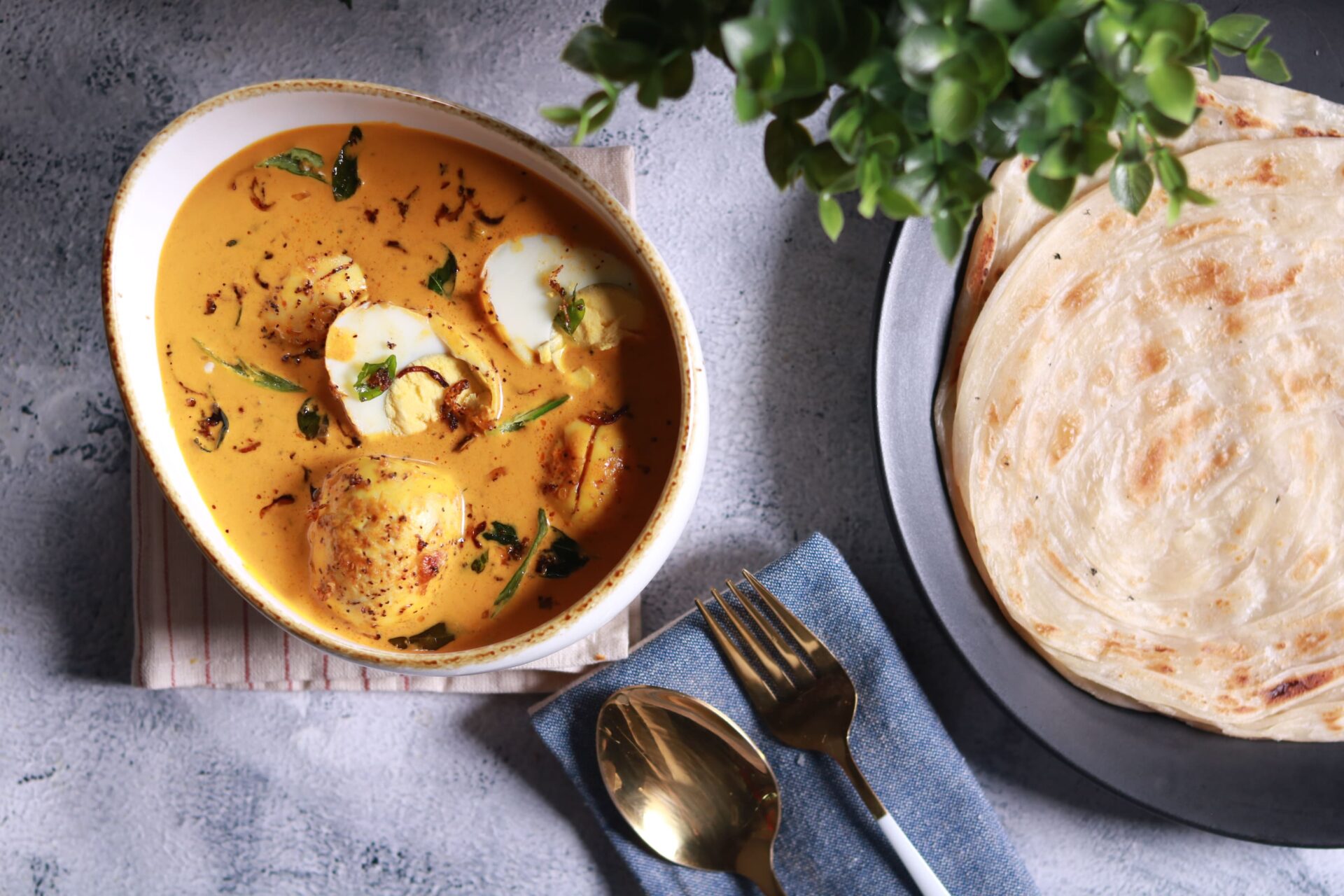
Traditional Kerala Egg Curry with Coconut Milk (Mutta Curry)
If there’s one dish that makes a slow, rainy morning in Kerala feel extra cozy, it’s a Traditional Kerala egg curry with coconut milk, served with soft Paratha or lacy dosa. This is the kind… Read more
-
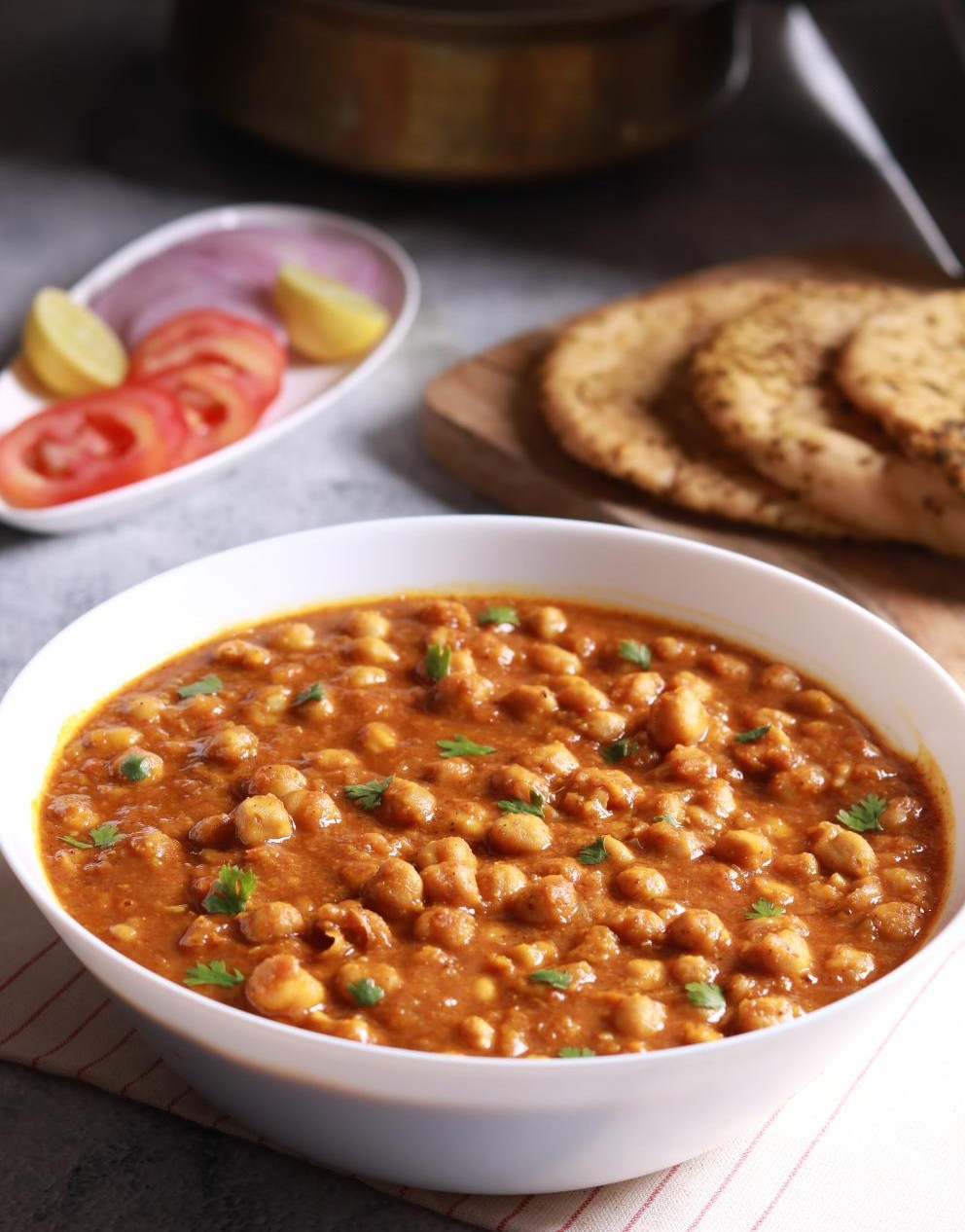
Chole Kulcha – The Heart of Punjabi Street Food
Chole Kulcha- If you’ve ever visited North India, you’ll know Chole Kulcha isn’t just a meal, it’s a whole experience. Picture bustling streets filled with the scent of spiced chickpeas, fluffy kulchas hot off the… Read more
-

Kala Chana Chaat :- A Wholesome Snack Bursting with Flavor
If you love Indian snacks that tick all the boxes: healthy, crunchy, tangy, and totally addictive, then Kala Chana Chaat is your new favourite. It’s a dish that comes together effortlessly yet feels incredibly refreshing.… Read more

